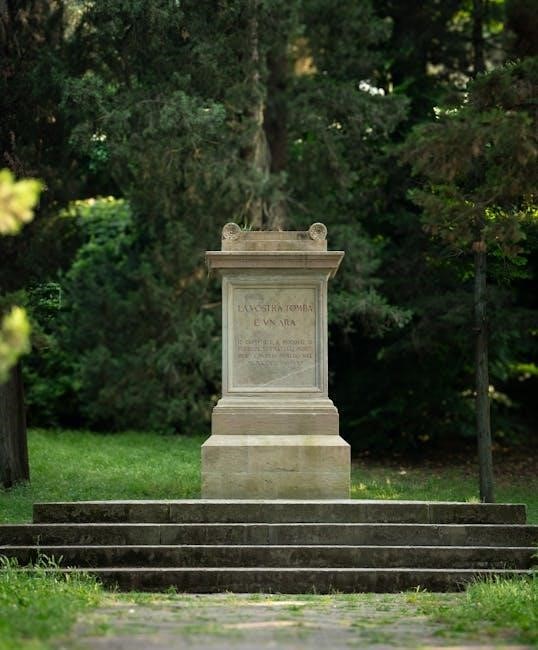Background of the Poem
Henry Wadsworth Longfellow’s The Village Blacksmith reflects his admiration for laborers. Inspired by a Cambridge smithy, it was published in 1841 in Ballads and Other Poems, celebrating hard work and resilience, now widely available as a PDF.
1.1 The Poet: Henry Wadsworth Longfellow
Henry Wadsworth Longfellow (1807–1882) was a renowned American poet and professor, celebrated for his lyrical and accessible works. Born in Portland, Maine, then part of Massachusetts, he came from a well-to-do family and began writing poetry at an early age. His first poem, The Battle of Lovells Pond, showcased his emerging talent. Longfellow became a prominent figure in 19th-century American literature, known for his ability to weave history, nature, and human emotion into his verses. While some critics viewed him as more of an adaptive poet than an innovative one, his popularity endured both in the U.S. and abroad. His legacy includes being the first American poet honored with a bust in Westminster Abbey’s Poets’ Corner in 1884, solidifying his place in literary history.
1.2 Publication and Popularity

The Village Blacksmith was first published in 1841 within Longfellow’s collection Ballads and Other Poems. The poem quickly gained popularity for its vivid portrayal of a blacksmith’s daily life, celebrating hard work and resilience. Its relatable themes and rhythmic language resonated with a broad audience, making it one of Longfellow’s most beloved works. Inspired by a Cambridge smithy Longfellow often passed, the poem reflects his appreciation for ordinary laborers. Today, The Village Blacksmith remains widely studied, with its PDF versions easily accessible online. Its enduring appeal lies in its ability to honor the dignity of work, ensuring its place in 19th-century American literary heritage.

Structure and Style of the Poem
The poem features a lyrical style with an anapestic meter, creating a rhythmic and musical quality. Its vivid imagery and descriptive language enhance its emotional and visual appeal.
2.1 Literary Devices and Imagery
Longfellow employs vivid imagery to depict the blacksmith’s strength and dedication. The poem uses similes, such as comparing muscles to “iron bands,” to emphasize physical prowess. The setting, “under a spreading chestnut-tree,” evokes a timeless, picturesque atmosphere. Personification adds depth, as the blacksmith’s tools and surroundings seem to echo his labor. Alliteration and rhythm enhance the lyrical quality, mirroring the blacksmith’s steady, rhythmic work. The imagery of “honest sweat” and “sinewy hands” underscores the poet’s celebration of hard work and resilience. These literary devices collectively create a heroic yet relatable figure, blending realism with poetic charm, making the blacksmith a symbol of enduring labor and dignity.
2.2 Rhythm and Meter
The poem’s rhythm and meter are integral to its musicality and emotional impact. Longfellow uses anapestic tetrameter, creating a rhythmic flow that mimics the blacksmith’s steady hammering. This meter, with its unstressed-stressed-unstressed pattern, gives the poem a lively, almost singable quality. The consistent rhythm mirrors the blacksmith’s daily routine, emphasizing his reliability and perseverance. The meter also enhances the poem’s lyrical and accessible nature, making it resonate with a broad audience. By combining rhythm and imagery, Longfellow crafts a vivid auditory experience, drawing readers into the blacksmith’s world. The poem’s structure reinforces its themes of labor and resilience, making it both a celebration of work and a testament to its enduring appeal.
Themes and Symbolism
The poem celebrates honest labor and perseverance, with the blacksmith symbolizing strength and dedication. His daily toil represents dignity in work and community contribution.
3.1 celebration of Honest Labor
3.1 Celebration of Honest Labor
Honest labor is central to The Village Blacksmith, as Longfellow portrays the blacksmith’s daily toil with admiration. The poem highlights the dignity and value of physical work, emphasizing the blacksmith’s strength and perseverance. Through vivid imagery, Longfellow illustrates the blacksmith’s unwavering commitment to his craft, from morning till night. The blacksmith’s “brawny arms” and “iron bands” symbolize his unrelenting effort and dedication. This celebration of labor not only honors the working class but also reflects the societal appreciation for craftsmanship during the 19th century. The poem’s focus on the blacksmith’s honest sweat and tireless efforts underscores the nobility of manual labor, making it a timeless tribute to hard work and integrity.
3.2 The Blacksmith as a Symbol
The blacksmith in Longfellow’s poem is more than a laborer; he is a symbol of strength, resilience, and community. His physical prowess and unwavering dedication to his craft represent the dignity of manual labor. The blacksmith’s role as a provider and a pillar of the village emphasizes his importance to society. Longfellow uses the blacksmith to symbolize the working class, highlighting their contributions and the value of their toil. The blacksmith’s steadfast nature and commitment to his work also serve as a metaphor for perseverance and honesty. Through this character, Longfellow celebrates the unsung heroes of everyday life, making the blacksmith a timeless symbol of hard work and integrity.

Historical Context
Published in 1841, the poem reflects 19th-century ideals, celebrating labor and community, inspired by Longfellow’s observations of a Cambridge blacksmith.
4.1 Inspiration Behind the Poem
The inspiration for The Village Blacksmith is often traced to a Cambridge smithy Longfellow frequently passed while walking to Harvard University. The poet was deeply moved by the blacksmith’s dedication, strength, and quiet pride in his work. This daily observation sparked Longfellow’s admiration for the working class and their contributions to society. The blacksmith, with his physical prowess and unwavering commitment, became a symbol of honesty and perseverance. Longfellow’s portrayal of the blacksmith’s life, set against the backdrop of a rural village, highlights the beauty of manual labor and the importance of community. The poem reflects Longfellow’s ability to find inspiration in everyday life and his appreciation for the unsung heroes of 19th-century America.
4.2 The Poem’s Place in 19th-Century Literature
The Village Blacksmith holds a significant place in 19th-century American literature as a celebration of the common man. Published in 1841 within Longfellow’s collection Ballads and Other Poems, it resonated with readers by portraying the dignity of manual labor. The poem’s accessible language and rhythmic style made it widely popular, aligning with the era’s appreciation for works that glorified everyday heroes. It reflects Longfellow’s ability to blend folklore with realistic portrayals of working-class life, a trend prevalent in 19th-century literature. The poem’s enduring appeal lies in its universal themes of hard work and perseverance, making it a cornerstone of American literary heritage. Its influence can be seen in later works that similarly emphasized the value of labor and community, solidifying its place in the literary canon.
Analysis of the Poem
The Village Blacksmith vividly portrays the blacksmith as a symbol of honest labor and perseverance, using imagery and rhythm to celebrate his strength and dedication.
5.1 Detailed Summary of the Poem
The poem The Village Blacksmith by Henry Wadsworth Longfellow describes the life and character of a blacksmith in a rural village; It begins by setting the scene under a spreading chestnut tree, where the village smithy stands. The blacksmith is portrayed as a strong, muscular man with sinewy hands and arms as robust as iron bands. His hair is crisp, black, and long, and his face is tanned from years of working outdoors. The poem highlights his daily routine, emphasizing his dedication to his craft and his role as a pillar of the community. It also touches on his family life, mentioning his wife and children, who gather around him on Sundays. The poem celebrates the dignity of labor and the quiet strength of the blacksmith, making it a timeless tribute to hard work and perseverance. The full text is available for download as a PDF.
5.2 Critical Interpretation
Critics have praised The Village Blacksmith for its vivid portrayal of working-class life in 19th-century America. The poem’s rhythmic and robust language mirrors the blacksmith’s physical labor, emphasizing strength and resilience. Longfellow’s use of imagery, such as the “spreading chestnut tree” and “sinewy hands,” creates a powerful visual narrative that celebrates the dignity of labor. Scholars note the poem’s symbolism, with the blacksmith representing honesty and perseverance. However, some critics argue that the portrayal idealizes labor, possibly oversimplifying the hardships faced by workers. Despite this, the poem remains a significant work in American literature, reflecting Longfellow’s admiration for ordinary people. The PDF version of the poem allows readers to delve into these themes and literary devices in detail.

Accessing the Poem
The poem is widely available as a PDF download on platforms like Poetry.com and educational websites, offering easy access to the full text and study resources.
6.1 PDF Downloads and Sources
The full text of The Village Blacksmith is readily available as a PDF download on various platforms, including Poetry.com and educational websites. These sources provide free access to the poem, allowing readers to study and appreciate Longfellow’s work. Many websites, such as DLTKs Poems and PinkMonkey, offer the poem in downloadable formats for easy reading. Additionally, libraries and academic databases often include PDF versions of the poem as part of their collections. These resources are ideal for students and scholars looking to analyze the poem in depth. The availability of PDF downloads ensures that The Village Blacksmith remains accessible to a wide audience, preserving its legacy as a classic of American literature.
6.2 Study Guides and Resources
Several study guides and resources are available to enhance understanding of The Village Blacksmith. Websites like PinkMonkey and Poetry.com offer detailed analyses, summaries, and critical interpretations of the poem. These guides provide insights into themes, literary devices, and historical context, making them invaluable for students and educators. Additionally, resources such as lesson plans and discussion questions can be found online, aiding in the teaching and exploration of the poem. These materials are designed to deepen comprehension and appreciation of Longfellow’s work, ensuring its relevance for modern readers. By utilizing these resources, readers can gain a richer understanding of the poem’s significance and its place in American literature.